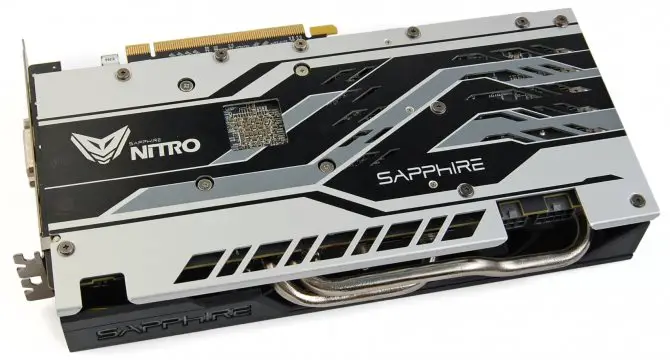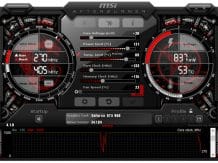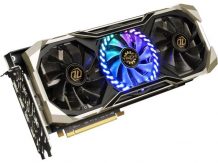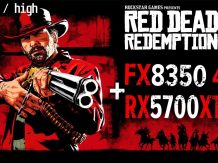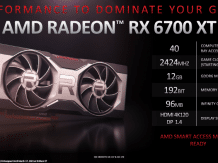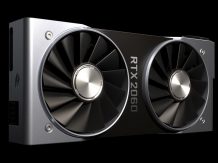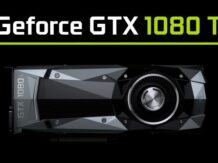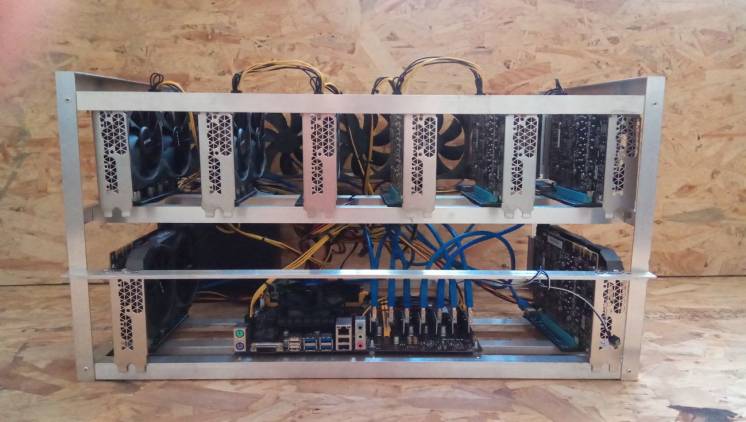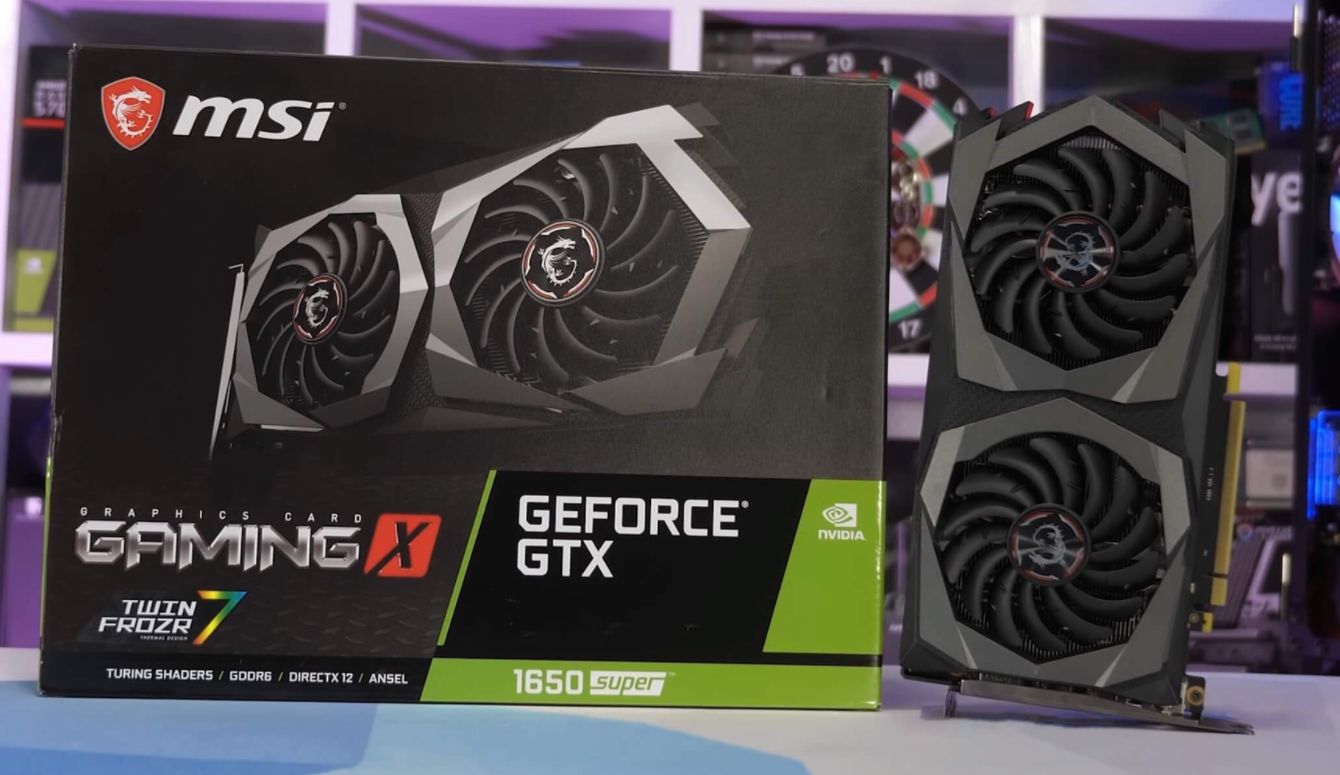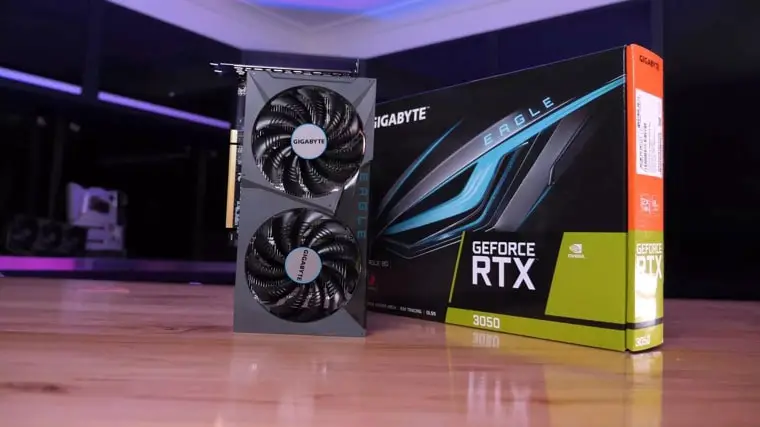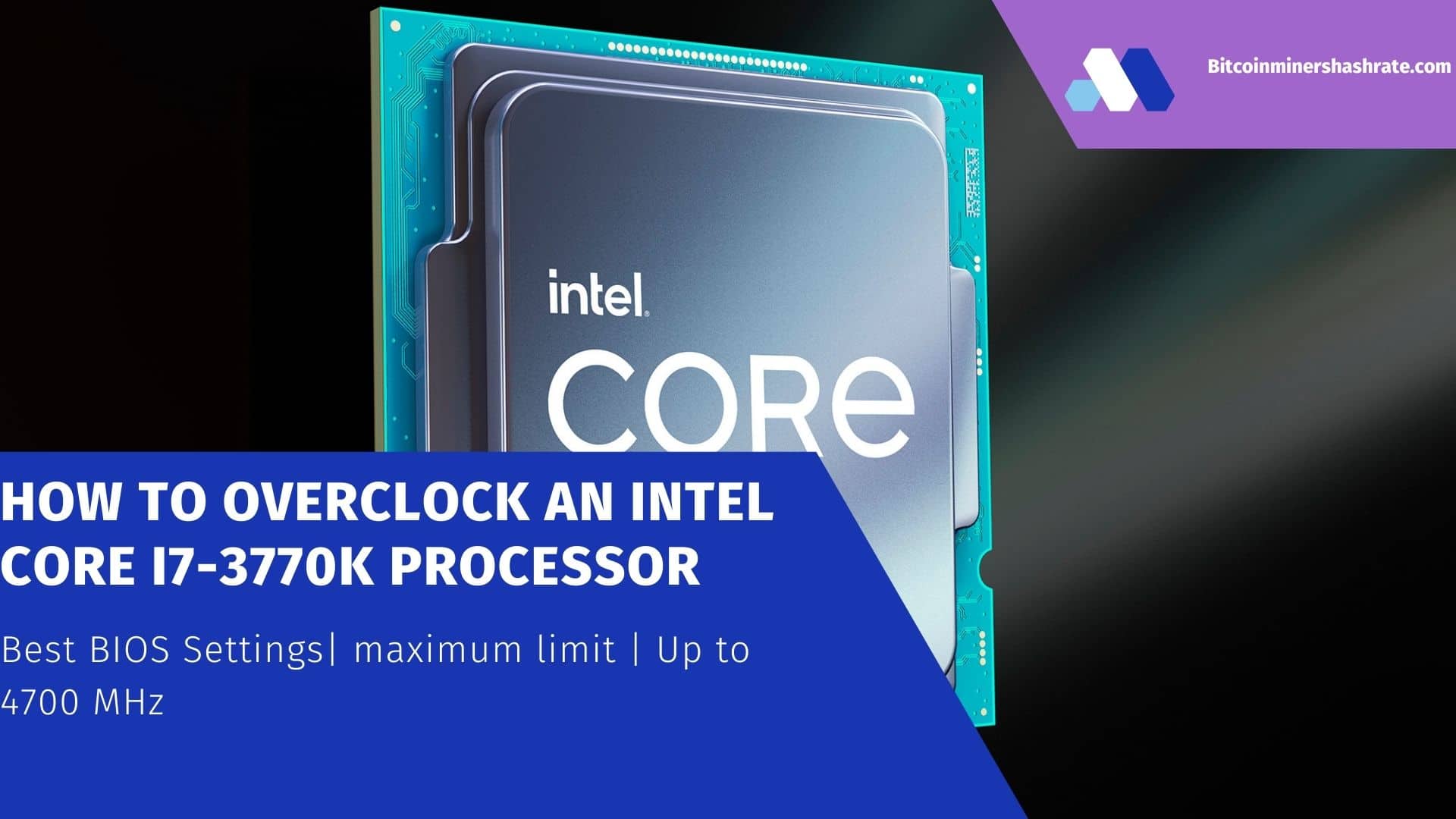How to ‘increase/ Max/ Optimize/ Boost’ AMD RX 580 8GB Gaming + Mining: Overclocking/ Best Settings/ Ether /MSI Afterburner Settings/ Hashrate/ How to tune RX 580 for mining: We will overclock AMD RX 580 8GB for mining using MSI Afterburner. You can find it in Yandex. The program interface is very simple, albeit a little colorful) To overclock the video card, we need two sliders:
- Core Clock – overclocking by the core, increases the core frequency;
- Memory Clock – memory overclocking, increases the memory frequency.
MSI Afterburner – Overclocking Video
Cards You need to change the frequency values a little at a time. Then test the stability of the work. If all is well, then we increase the frequency even more. If the video card starts to malfunction or the driver crashes, then we just reduce the frequency and that’s it. There will be no harm. Next, we will look at the overclocking parameters for the popular alogorites.
How to increase AMD RX 580 8GB Mining: bOverclocking AMD RX 580 8GB for Ether
To overclock AMD RX 580 8GB for mining ether or other coins using the DaggerHashimoto algorithm, you need to increase the memory frequency, and on the contrary, lower the core to save energy. it does not affect the mining speed.
Optimal overclocking parameters:
| Details | Hashrate | Program | Core Memory Power |
| GIGABYTE RX 580 AORUS • Unknown Miner | 23.7 MH / s- 32.02 MH / s (+8.3) DaggerHashimoto ETH | AMD Radeon Software | -185 +200 60% |
| Sapphire AMD Radeon RX 580 8GB NITRO+ • Георгий | 30.5 MH / s- 32.3 MH / s (+1.8) DaggerHashimoto ETH | MSI Afterburner | -211 200 60% |
| GIGABYTE RX 580 AORUS • Paul | 26.0 MH / s- 33.26 MH / s (+7.3) DaggerHashimoto ETH | AMD Radeon Software | -10 2250 100% |
| GIGABYTE RX 580 GAMING • Paul | 26.0 MH / s- 30.5 MH / s (+4.5) DaggerHashimoto ETH | AMD Radeon Software | -7 2050 100% |
Video accelerator Sapphire Pulse RX 580 8GD5 (8 GB)
Content
- Features of the device (s)
- Testbed configuration, list of testing tools
- Test results
- conclusions
Reference materials
- Gaming Graphics Card Buyer’s Guide
- AMD Radeon HD 7xxx / Rx Reference
- Nvidia GeForce GTX 6xx / 7xx / 9xx Reference
- Full HD video processing capabilities
- Testing methodology in 3D games and settings
Object of study
: Commercially available 3D graphics accelerator (graphics card) Sapphire Pulse RX 580 8GD5 8GB 256-bit GDDR5
Manufacturer information
: Sapphire Technology (Sapphire trademark) was founded in 2001 in Hong Kong as a subsidiary of the largest concern for the production of PC components – PC Partner. Focused on the release of products based on cores (graphics processors) ATI (later became part of AMD). Headquartered in Hong Kong, manufacturing in China. The largest manufacturer of accelerators in the Radeon series. It also produces system (motherboard) boards based on AMD chipsets, as well as mini-PCs and other products.
Sapphire Pulse RX 580 8GD5 (8 GB): Device (s)
| Sapphire Pulse RX 580 8GD5 8GB 256-bit GDDR5 (SKU 11265-05, P / N 299-4E353-010SA) | |||
| Parameter | Meaning | Nominal value (reference) | |
| GPU | Radeon RX 580 (Polaris 20) | ||
| Interface | PCI Express x16 | ||
| GPU frequency (ROPs), MHz | 1276—1366 | 1257—1340 | |
| Memory frequency (physical (effective)), MHz | 2000 (8000) | 2000 (8000) | |
| Memory bus width, bit | 256 | ||
| GPU Computing Units | 36 | ||
| Number of operations (ALU) per block | 64 | ||
| Total number of ALUs | 2304 | ||
| Texture units (BLF / TLF / ANIS) | 144 | ||
| ROP units | 32 | ||
| Dimensions, mm | 235×110×38 | 220×100×35 | |
| The number of slots in the system unit occupied by the video card | 2 | 2 | |
| PCB color | black | black | |
| Energy consumption | Peak in 3D, W | 170 | 175 |
| 2D mode, W | 22 | 22 | |
| In the “sleep” mode, W | 3 | 3 | |
| Noise level | 2D mode, dBA | 18,0 | 18,0 |
| 2D mode (video viewing), dBA | 18,0 | 18,0 | |
| In maximum 3D mode, dBA | 25,0 | 25,5 | |
| Output jacks | 1×DVI (Dual-Link/HDMI), 2×HDMI 2.0b, 2×DisplayPort 1.3/1.4 | 1×HDMI 2.0b, 3×DisplayPort 1.3/1.4 | |
| Multiprocessor support | CrossFire | ||
| Maximum number of receivers / monitors for simultaneous image display | 4 | 4 | |
| Additional power: number of 8-pin connectors | 1 | Not | |
| Auxiliary power supply: number of 6-pin connectors | Not | 1 | |
| Maximum 2D Resolution | Display Port | 4096×2160 | |
| HDMI | 4096×2160 | ||
| Dual-Link DVI | 2560×1600 | ||
| Single-Link DVI | 1920×1200 | ||
| Maximum 3D Resolution | Display Port | 4096×2160 | |
| HDMI | 4096×2160 | ||
| Dual-Link DVI | 2560×1600 | ||
| Single-Link DVI | 1920×1200 |
Search prices in the iXBT.com catalog
| Equipped with local memory |
| The card has 8 GB of GDDR5 SDRAM located in 8 8 Gbit chips on the front side of the PCB. Samsung memory chips (GDDR5) are rated for a nominal operating frequency of 2000 (8000) MHz. |
| Comparison with reference design | |
| Front view | |
| Sapphire Pulse RX 580 8GD5 8GB 256-bit GDDR5 | AMD Radeon RX 580 |
| Back view | |
| Sapphire Pulse RX 580 8GD5 8GB 256-bit GDDR5 | AMD Radeon RX 580 |
The PCB is redesigned and differs from the reference design.
The power system received 4 phases for the GPU and 1 phase for the memory chips, and is controlled by the On Semiconductor NCP81022 digital controller. The accelerator is manufactured using a set of high quality Black Diamond 4 chokes, which, according to the manufacturer, heat up 15% less than the previous generation.
The proprietary utility allows you to control the frequencies of the card and monitor the state of the accelerator.
In the overclocking mode (by default), the frequencies of this accelerator are increased relative to the standard parameters of the reference card by 2%, which can provide a performance increase of 1.5% -2% depending on the resolution and operating mode (that is, it is impossible to notice it).
| Cooling system |
| The main part of the cooling system is a massive nickel-plated plate radiator, pierced with heat pipes pressed into the base, which ensure an even distribution of heat along the radiator fins. Above the radiator is a shroud with two 95mm fans operating at the same speed. According to the manufacturer, these fans received double bearings, which should increase the fan life by 1.8 times. This cooler stops the fans in case of idle or light load (if the GPU temperature is not higher than 52 degrees). Therefore, do not be alarmed if the fans on the accelerator do not rotate when starting the PC. The fans are very easy to remove from the cooler for cleaning. Memory chips and power transistors are cooled by a central radiator. A thick plate is installed on the back of the video card, which provides rigidity to a relatively massive video card (preventing bending of the printed circuit board), and also protects the logic elements soldered on the back of the PCB from damage. After a 6-hour run under load, the maximum core temperature did not exceed 76 degrees, which is a good result for a video card of this level. |
| Temperature Monitoring with MSI Afterburner (by A. Nikolaychuk AKA Unwinder) |
Noise measurement technique
- The room is noise-insulated and damped, reverberations are reduced.
- The system unit, in which the noise of video cards was studied, does not have fans and is not a source of mechanical noise.
- The background level of 18 dBA is the noise level in the room and the noise level of the sound level meter itself.
- The measurements were taken at a distance of 50 cm from the video card at the level of the cooling system.
- Measurement modes:Idle mode in 2D: loaded internet browser with iXBT.com website, Microsoft Word window, a number of internet communicators.
- 2D mode with movie viewing: SmoothVideo Project (SVP) is used – hardware decoding with insertion of intermediate frames.
- 3D mode with maximum load on the accelerator: using FurMark benchmark.
- The assessment of the noise level gradations is carried out according to the method described here: 28 dBA or less: the noise is hardly distinguishable even at a distance of one meter from the source, even with a very low background noise level. Rating: minimal noise.
- from 29 to 34 dBA: the noise is discernible already from two meters from the source, but does not particularly draw attention to itself. It is quite possible to put up with this level of noise even with long-term operation. Rating: noise is low.
- from 35 to 39 dBA: noise is confidently different and noticeably attracts attention, especially in a room with a low noise level. You can work with this level of noise, but it will be difficult to sleep. Rating: average noise.
- 40 dBA or more: such a constant noise level is already beginning to annoy, you quickly get tired of it, you have a desire to leave the room or turn off the device. Rating: noise is high.
In idle mode in 2D, the temperature was 37 ° C, the fans were not working. The noise was equal to the background noise – 18.0 dBA.
When watching a movie with hardware decoding, the temperature rose to 46 ° C, the fans did not work. The noise was equal to the background noise – 18.0 dBA.
Under maximum load in 3D, the temperature reached 76 ° C. At the same time, the fans spun up to 1274 rpm, the noise rose to 25.0 dBA. This CO can be classified as quiet (the noise level is minimal).
Thermal image
The greatest heating is on the back side in the GPU area.
| Equipment |
| The basic package must include a user’s manual, a CD with drivers and utilities. We see the basic kit. |
RX 580 8GD5 (8 GB): Installation and Drivers
Test bench configuration
- Computer based on AMD Ryzen 7 1800X processor (Socket AM4): AMD Ryzen 7 1800X processor (o / c 4 GHz);
- СО Antec Kuhler H2O 920;
- Asus ROG Crosshair VI Hero motherboard based on AMD X370 chipset;
- RAM 16 GB (2 × 8 GB) DDR4 AMD Radeon R9 UDIMM 3200 MHz (16-18-18-39);
- Seagate Barracuda 7200.14 3TB SATA2 hard drive;
- Seasonic Prime 1000 W Titanium power supply unit (1000 W);
- operating system Windows 10 Pro 64-bit; DirectX 12;
- monitor Samsung U28D590D (28 ″);
- AMD drivers Crimson ReLive Edition 17.7.2;
- Nvidia drivers version 384.94;
- VSync is disabled.
Testing tool list
Testing methodology and all settings can be viewed here.
- Fallout 4
(Bethesda Games Studios/Bethesda Softworks, DirectX 11) - Rise Of The Tomb Raider
(Nixxes Software/Square Enix, DirectX 12) - Tom Clancy’s Ghost Recon Wildlands
(Ubisoft/Ubisoft, DirectX 11) - The Witcher 3: Wild Hunt
(CD Projekt RED, DirectX 11) - BattleField 1
(EA Digital Illusions CE/Electronic Arts, DirectX 12) - Tom Clancy’s The Division
(Ubisoft Massive/Ubisoft, DirectX 11) - Deus Ex: Mankind Divided
(Eidos Montreal/Square Enix, DirectX 12) - Far Cry Primal
(Ubisoft/Ubisoft, DirectX 11) - Hitman (2016)
(IO Interactive/Square Enix, DirectX 12) - Ashes Of The Singularity
(Oxide Games,Stardock Entertainment/Stardock Entertainment, DirectX 12)
Test results: performance comparison
- Fallout 4 All resolutions on one page
Resolution 1680×1050 - Resolution 1920 × 1200
- 2560 × 1600 resolution
- Resolution 3840 × 2160
- Rise Of The Tomb Raider All permissions on one page
Resolution 1680 × 1050 - Resolution 1920 × 1200
- 2560 × 1440 resolution
- Resolution 3840 × 2160
- Tom Clancy’s Ghost Recon Wildlands All permissions on one page
Resolution 1680 × 1050 - Resolution 1920 × 1200
- 2560 × 1440 resolution
- Resolution 3840 × 2160
- The Witcher 3: Wild Hunt All permissions on one page
Resolution 1680 × 1050 - Resolution 1920 × 1200
- 2560 × 1600 resolution
- Resolution 3840 × 2160
- BattleField 1 All permissions on one page
Resolution 1680 × 1050 - Resolution 1920 × 1200
- 2560 × 1440 resolution
- Resolution 3840 × 2160
- Tom Clancy’s The Division All permissions on one page
Resolution 1680 × 1050 - Resolution 1920 × 1200
- 2560 × 1440 resolution
- Resolution 3840 × 2160
- Deus Ex: Mankind Divided All permissions on one page
Resolution 1680 × 1050 - Resolution 1920 × 1200
- 2560 × 1440 resolution
- Resolution 3840 × 2160
- Far Cry Primal All permissions on one page
Resolution 1680 × 1050 - Resolution 1920 × 1200
- 2560 × 1600 resolution
- Resolution 3840 × 2160
- Hitman (2016) All permissions on one page
Resolution 1680 × 1050 - Resolution 1920 × 1200
- 2560 × 1600 resolution
- Resolution 3840 × 2160
- Ashes Of The Singularity All permissions on one page
Resolution 1680 × 1050 - Resolution 1920 × 1200
- 2560 × 1440 resolution
- Resolution 3840 × 2160
conclusions
| IXBT.com Rating | ||||
| Explanation | Date when prices were taken from retail to generate Utility Ratings | |||
| The iXBT.com accelerator rating shows us the functionality of video cards relative to each other and is normalized by the weakest accelerator – GeForce GT 730 (that is, the combination of speed and GT 730 functions is taken as 100%). Ratings are conducted by 30 accelerators that we study monthly within the i3D-Speed framework (the rating methodology can be found here). A group of maps is selected for analysis, which includes the RX 580 and its competitors. Utility ratings are calculated using retail prices for the period shown on the right. | early August 2021 | |||
| № | Accelerator name | IXBT.com Rating | The rating is useful. | Price |
| 06 | Sapphire Pulse RX 580 8GD5 (8 ГБ), 1276—1366/8000 | 3000 | 1364 | 22 000 |
| 07 | RX 580 8 GB, 1257-1340 / 8000 | 2950 | 1305 | 22 600 |
| 09 | GTX 1060 6 ГБ, 1507—1860 / 8000 | 2750 | 1146 | 24 000 |
| 10 | GTX 980 4 ГБ, 1126 — 1266/7000 | 2740 | 1100 | 24 900 |
| 13 | R9 390 8 GB, 1000/1000/6000 | 2510 | 930 | 27 000 |
| 15 | GTX 970 4 ГБ, 1050—117 7/7000 | 2340 | 996 | 23 500 |
Commentary on iXBT.com Ratings
The RX 580 is a direct competitor to the GTX 1060 6GB and looks great in this comparison. The rest of the competitors close in level are also slower.
| Utility rating | ||||
| Explanation | Date when prices were taken from retail to generate Utility Ratings | |||
| The utility rating of the same cards is obtained if the indicators of the previous rating are divided by the prices of the corresponding accelerators | early August 2021 | |||
| № | Accelerator name | The rating is useful. | IXBT.com Rating | Price |
| 04 | Sapphire Pulse RX 580 8GD5 (8 ГБ), 1276—1366/8000 | 1364 | 3000 | 22 000 |
| 07 | RX 580 8 GB, 1257-1340 / 8000 | 1305 | 2950 | 22 600 |
| 13 | GTX 1060 6 ГБ, 1507—1860 / 8000 | 1146 | 2750 | 24 000 |
| 15 | GTX 980 4 ГБ, 1126 — 1266/7000 | 1100 | 2740 | 24 900 |
| 20 | GTX 970 4 ГБ, 1050—117 7/7000 | 996 | 2340 | 23 500 |
| 24 | R9 390 8 GB, 1000/1000/6000 | 930 | 2510 | 27 000 |
Commentary on Utility Ratings
Due to the massive obsession with mining, upper and middle-level video cards were massively sold out, a severe deficit was formed, so prices skyrocketed. Now the prices are gradually returning to an adequate state, and we even managed to find the RX 580 on sale at a more or less normal price (although we are not sure if this was not a one-off case). And given the normal prices, the RX 580 has an edge in its group in our ranking.
Sapphire Pulse RX 580 8GD5 (8GB)
Is a great variant of the Radeon RX 580, with slightly better performance than the reference card and a very efficient and quiet cooling system. The presence of 8 gigabytes of memory provides good potential for today’s powerful games. The accelerator also demonstrates excellent value for money (subject to value for money).
The final decision traditionally remains with our readers (look at the current prices below!).
In the “Original Design” nomination (for August 2021), the award was given to the card:
- Sapphire Pulse RX 580 8GD5 8GB 256-bit GDDR5
| Average current price (number of offers) in Moscow retail: | |
| Cards in question | Competitors |
| RX 580 8 GB – 27,000 rubles. (on 08.09.17) | GTX 970 – 20,000 rubles. (on 09/08/17) |
| RX 580 8 GB – 27,000 rubles. (on 08.09.17) | GTX 980 – 24,000 rubles. (on 09/08/17) |
| RX 580 8 GB – 27,000 rubles. (on 08.09.17) | R9 390 – 27 000 (on 03.08.17) |
| RX 580 8 GB – 27,000 rubles. (on 08.09.17) | GTX 1060 6 GB – 19700 rubles. (on 09/08/17) |
| Sapphire Pulse RX 580 8GD5 (8 ГБ) — T-1723638347 | RX 580 8 GB – 27,000 rubles. (on 08.09.17) |
Thanks to Sapphire Russia
and personally to
Elena Zarubina
for the video card provided for testing
| Seasonic Prime 1000 W Titanium power supply for the test bench was provided by Seasonic. | AMD Radeon R9 8 GB UDIMM 3200 MHz memory modules for the test bench provided by AMD | Asus ROG Crosshair VI Hero motherboard for testbed provided by AMD. | CPU Cooler Antec Kuhler H2O 920 for testbed provided by AMD |
| Dell UltraSharp U3011 Testbed Monitor Courtesy of Yulmart | Corsair Obsidian 800D Full Tower Testbed Case Courtesy of Corsair | Seagate Barracuda 7200.14 3TB Testbed Hard Drive Courtesy of Seagate |
How to Maximize Hashrate: AMD RX 580 8GB
We have compiled an AMD RX 580 8GB hashrate table for popular algorithms. If you are just choosing a video card for mining, and you already know what kind of coin you will mine, then you can estimate the approximate performance from the table. We also have an article on what a hash rate is.
| Coin | Algorithm | Hashrate |
| Ethereum (ETH) | DaggerHashimoto ETH | 32.2 MH / S |
| Expanse (EXP) | DaggerHashimoto EXP | 32.2 MH / S |
| Ubiq (UBQ) | Bashash | 32.2 MH / S |
| Currency (XMR) | RandomX | 470,0 H/S |
| Grin (GRIN) | Cuckarooz29 | 2,2 H/S |
| Ravencoin (RVN) | KawPow | 13.0 MH / S |
| Beam (BEAM) | BeamHashIII | 13,5 H/S |
Review and testing of the Sapphire Nitro + Radeon RX 580 4GB video card. Comparison with GeForce GTX 1060 6GB
Returning to the current confrontation between middle-class video cards. The hype from miners has led to scarcity and overpricing of the Radeon RX 580 and GeForce GTX 1060. But these graphics adapters are still in demand among a wide range of consumers. In this review, we will look at the budget version of the Radeon RX 580 with a reduced memory size and at the same time conduct a new comparative test with the GeForce GTX 1060, adding new games to the list of tests. Test applications include the main hits of the fall (Assassin’s Creed Origins, Wolfenstein II), the new role-playing game Kingdom Come: Deliverance and other projects
The focus is on the Sapphire Nitro + Radeon RX 580 4GB (11265-07) video card, which has not only a reduced memory size, but also non-standard frequency characteristics. Let’s see how well it competes with the GeForce GTX 1060 6GB in Full HD resolution, for which all tests will be accompanied by comments on video memory load. Well, we will definitely check the overclocking potential.
Sapphire Nitro+ Radeon RX 580 4GB
The Sapphire graphics accelerator came to us without factory packaging in a regular box, so let’s move on to examining the device itself.

Video adapter 25 cm long, occupies two expansion slots. The cooling system is equipped with two fans, thick heat pipes peep out on the sides.

The plastic case has pseudo-perforation, which visually looks interesting. The fans feature the Sapphire Nitro logos. Outwardly, it is very similar to the Sapphire Pulse Radeon RX 580 8GD5.

A large, illuminated Sapphire logo is located on the side of the casing. Also, two large heat pipes stretch along the edge.

The back side of the board is covered with a metal plate with a geometric pattern on the surface. In a small niche there are two power connectors – six and eight contacts.

The rear panel has five connectors for image output: two DisplayPort and HDMI, plus one DVI. Sapphire Nitro is specially equipped with HDMI pair for easy and quick connection of a VR headset.

Let’s take a look at the cooling system with the shroud removed. This is a rather large heatsink with four heat pipes – two with an increased diameter of 8 mm and two of 6 mm each.

The heatsink has a large base that contacts the memory chips. In the center there is a copper plate that removes heat from the graphics chip. Also on the heatsink there is a ledge with a soldered plate, which is a contact pad for VRM elements. So a single cooler removes heat from all elements on the board at once.

On the reverse side of the board, in the VRM area, there is a contact with the reinforcing plate. For this there is an additional plate, which is pressed to the board through a large thermal pad. Thermal paste is applied to the top of the plate, which improves contact with the backplate. We saved a little on the paste itself, but such a careful approach to cooling the power supply unit inspires respect.

The PCB resembles a Sapphire Pulse Radeon RX 580 8GD5 with boosted power. High quality electronic components are used, in particular, special ribbed chokes and black polymer capacitors.

The GPU power system has six phases.

The GPU crystal is surrounded by a large protective frame.

Eight Elpida W4032BABG-70-F memory chips are soldered. Such chips can be found on the Radeon RX 570. Unfortunately, we have not preserved a good complete image, below is a collage of two fragments, which shows the marking.

The video adapter operates at an increased core frequency of 1400 MHz. The memory operates at an effective frequency of 7000 MHz, which is typical for a Radeon RX 580 with 4 GB, while older versions with 8 GB operate at 8000 MHz.

It should also be noted that the official specifications of Sapphire Nitro + Radeon RX 580 4GB indicate an even higher core frequency of 1411 MHz. Perhaps our copy differs from the current versions in the BIOS firmware. In any case, this 11 MHz is not a critical value.
Under gaming load, the video card showed stable 1400 MHz in almost all games. The most noticeable drops to 1375 MHz occurred in Subnautica (bottom left screenshot). On an open bench at 23 ° C indoors, the video card core warmed up to 69-73 ° C. In this case, the fans worked in the range of 1400–2200 rpm. Everything depended heavily on the load in each individual application. As an example, below are screenshots of monitoring parameters in Subnautica and Kingdom Come: Deliverance.

Please note that temperatures are below 70 ° C. But when passing several runs of the Assassin’s Creed Origins benchmark, the core reached 73 ° C with a fan speed of 1200-1400 rpm.

As a result, we can say that in games the video card shows moderate temperatures and often works with little noise. However, under more severe operating conditions inside the enclosure, heat and noise may be higher.
As a result of overclocking experiments, this video adapter showed the best GPU potential among all previously tested Radeon RX 570/580. Some gaming tests were able to pass at frequencies up to 1470 MHz. However, the stable “ceiling” turned out to be lower, we settled on the value of 1450 MHz. From memory they reached 2015 (8060) MHz, higher frequencies led to artifacts and a drop in stability.

Overclocking to frequencies of 1450/8060 MHz was accompanied by an increase in the power limit. The fan speed was fixed at 2200 RPM, which helped keep core temperatures below 66 ° C, although the noise level was rather high.
Characteristics of the tested video cards
To get an analogue of the older video card Radeon RX 580 with floating frequencies in Boost mode, the core frequency for Sapphire is limited to 1320 MHz. The memory was accelerated to the prescribed 8000 MHz.
The rival will be the Gigabyte GV-N1060WF2OC-6GD video card, one of the simplest non-reference models of this series, more about it will be described in a separate review. In the nominal, Gigabyte’s frequencies were brought to the recommended level, which often meant an average Boost at 1848 MHz or slightly lower.
| Video adapter | Sapphire Nitro+ RX 580 4GB | Radeon RX 580 | GeForce GTX 1060 6GB |
| Core | Polaris 20 | Polaris 20 | GP106 |
| Number of transistors, mln.pcs | 5700 | 5700 | 4400 |
| Process technology, nm | 14 | 14 | 16 |
| Core area, sq. mm | 232 | 232 | 200 |
| Number of stream processors | 2304 | 2304 | 1280 |
| Number of texture units | 144 | 144 | 80 |
| Number of rendering units | 32 | 32 | 48 |
| Core frequency, MHz | 1400 (1411) | 1257–1340 | 1506–1708 |
| Memory bus, bit | 256 | 256 | 192 |
| Memory type | GDDR5 | GDDR5 | GDDR5 |
| Memory frequency, MHz | 7000 | 8000 | 8000 |
| Memory size, MB | 4096 | 8192 | 6144 |
| Supported DirectX Version | 12 | 12 | 12 |
| Interface | PCI-E 3.0 | PCI-E 3.0 | PCI-E 3.0 |
| Power, W | — | 185 | 120 |
The table shows the official specifications. The graphs show the full frequency range including peak Boost values.
Test stand
The test bench configuration is as follows:
- processor: Intel Core i7-6950X (3, [email protected], 1 GHz);
- cooler: Noctua NH-D15 (two NF-A15 PWM fans, 140 mm, 1300 rpm);
- motherboard: MSI X99S MPower (Intel X99);
- memory: G.Skill F4-3200C14Q-32GTZ (4 × 8 GB, DDR4-3200, CL14-14-14-35);
- system drive: Kingston SSDNow KC400 (512 GB, SATA 6Gb / s);
- additional disk: Hitachi HDS721010CLA332 (1 TB, SATA 3Gb / s, 7200 rpm);
- power supply unit: Seasonic SS-750KM (750 W);
- monitor: ASUS PB278Q (2560×1440, 27 ″);
- operating system: Windows 10 Pro x64;
- Radeon driver: AMD Adrenalin Edition 18.2.2;
- GeForce driver: NVIDIA GeForce 390.77.
Testing technique
The tests were carried out in a resolution of 1920 × 1080 at the maximum or close to this level graphics settings.
Assassin’s Creed Origins
For testing, the built-in gaming benchmark was used, which was run several times for each video adapter.
A standard profile of the highest Ultra quality is selected.
Battlefield 1
Selected a new test scene on a large map with difficult terrain. This is the beginning of the second mission of the “Go Savoy!” Story campaign. The same sequence of actions was performed with shooting and throwing grenades. The duration of the test episode is 52 seconds. At least seven repetitions.
Selected Ultra-quality graphics. Tested in DirectX 11 using Fraps and DirectX 12 using Mirillis Action!
Call of Duty: WWII
Performance comparisons were made early in the game. A platoon of soldiers rushes on a landing ship to the coast of Normandy under enemy fire. A simple episode rich in visuals. The duration of the test segment is 110 seconds.
The highest graphics quality and cinematic SMAA T2x anti-aliasing are set.
Divinity: Original Sin 2
An identical sequence of actions was performed for testing, which combines the use of magic and a walk through a detailed village. The procedure is shown below.
Maximum graphics quality selected.
Elex
Testing was done with Fraps at the start of the game after going down the elevator. A walk was performed along a certain route, several repetitions. Abundant vegetation and bright lighting put a lot of stress on this simple test scene.
Maximum graphics quality for all parameters and SMAA anti-aliasing.
Fallout 4
Testing was done with Fraps right after leaving the hideout at the start of the game. We took a short walk through the surroundings with an abundance of vegetation and rich rays of light. Scenes with this environment will cause the most noticeable performance degradations. The procedure is shown below.
The profile of the highest quality graphics is selected, in addition, the shading of HBAO + is used.
Kingdom Come: Deliverance
Testing was done with Fraps at the start of the game. A run from the smithy to the city market was carried out. There are drawdowns in the game with changes in illumination during the transition from an external location to the premises, therefore such a moment is included in the test walk. The entire sequence of actions is reflected in the video clip.
A very high quality profile has been selected. The fps limit was removed via the r_vsync 0 command in the console.
Middle-earth: Shadow of War
For testing, the built-in gaming benchmark was used, which was run 5-6 times on each video card.
The game has extremely high demands on video memory. In order not to initially put our Radeon in a restrained position, the Ultra-quality profile is selected, but the textures are lowered to a high level.
Remothered: Tormented Fathers
A small walk in the courtyard of the mansion at the beginning of the game was repeated. Several repetitions.

The standard Ultra quality profile is selected.
SpellForce 3
Testing was carried out at the location “Gray Citadel”. It is a large detailed level with lots of detail and thick fog at the foot of the cliffs. A walk was performed along a small route relative to the first portal with manual movement of the camera. Additional rotation of the camera around one of the objects was performed.

The highest quality graphics, all sliders to the maximum. Only the shadow resolution is kept at the level that the game offers. These settings are illustrated below.

Subnautica
Beginning of the game. A small swim was made along the initial location through the shallows to the territory with algae. Several repetitions.

High quality standard profile. Additionally, the global shading parameters and the quality of reflections are increased to the maximum.

The Evil Within 2
Testing was carried out by replaying a small episode at the very beginning of the game, when the hero runs into a burning building. Frame rates measured by Fraps, six repetitions.
The highest graphics quality is selected, Very High.
Wolfenstein II: The New Colossus
An episode with a shootout was selected for testing in order to simulate a typical game situation. We grab a laser cannon and deal with a group of enemies, making several accompanying explosions, shooting from a machine gun.
The highest quality profile Mein Leben has been selected! Low-level caching (“Image Transfer”) is enabled to reduce memory usage.
3DMark Time Spy
Testing with standard settings in default mode.
Test results
Assassin’s Creed Origins

The best results in Assassin’s Creed Origins are shown by the GeForce GTX 1060, and the Radeon RX 580 is inferior to about 10%. Overclocking allows you to catch up with the competitor. The load of video memory is approaching 4 GB.
Read more about in-game performance in the dedicated benchmark.
Battlefield 1
Radeon RX 580 is faster than the competitor in any DirectX version. At the same time, the transition from DirectX 11 to DirectX 12 provides a slight drop in fps for all participants. Sapphire Nitro + at the initial frequencies does not differ much from the Radeon RX 580 with standard frequencies, the gain from overclocking is about 5%. Load video memory up to 3 GB in DirectX 11, and up to 3.2 GB in DirectX 12.
Call of Duty: WWII

AMD representatives are faster than the GeForce GTX 1060 in the new Call of Duty, albeit with a minimal difference. The advantage of Sapphire Nitro + over a regular video card is about 2%, an increase from overclocking to 6%. As for the load of video memory, the game can load the entire available volume, even on models with 8 GB, but this factor has little effect on performance.
Divinity: Original Sin 2

In Original Sin 2, the first place belongs to the GeForce GTX 1060. The Sapphire video adapter shows the same performance at maximum frequencies. At par, it is 3% faster than the regular Radeon RX 580.
Read more about in-game performance in the dedicated benchmark.
Elex

After a number of updates, the game has slightly changed visually, the overall color scheme has changed, the depth of field effect is less involved, and more rain. As a result, the results obtained may differ from those that were in the first testing in this game. Sapphire and GeForce GTX 1060 have very similar performance, the regular Radeon RX 580 is slightly weaker. In overclocking, the lag behind NVIDIA’s rival is more obvious. The load of video memory in the test scene is 3.1 GB.
Fallout 4

After adding HD textures in Fallout 4, we got unstable results for a long time on AMD solutions, but finally the performance on Radeon stabilized, and the minimum fps increased. This is a good reason to re-compare.

Now the difference between the Radeon RX 580 and the GeForce GTX 1060 is minimal, and Sapphire is quite comparable to its rival. In overclocking, the GeForce GTX 1060 already has a clear advantage.
Kingdom Come: Deliverance

In this new game, the Radeon RX 580 leads, beating the GeForce GTX 1060 by 9-13%. Sapphire is another 3% faster, overclocking provides about the same acceleration. During the test walk, 2 GB of video memory was loaded.
Middle-earth: Shadow of War

Ultra textures hit the performance of the 4GB Radeon RX 580 critically, as seen in our dedicated testing. The combination of the maximum graphics settings with the usual high quality textures is much easier – the lag behind the GeForce GTX 1060 is only a few percent. Sapphire’s results are almost indistinguishable from the standard version of the Radeon RX 580. Increase from overclocking to 6%.
Remothered: Tormented Fathers

A colossal gap between the participants. The GeForce GTX 1060 has a significant lead over the competitor. There is no optimization for Radeon RX here at all. The download of video memory barely exceeds 2 GB.
SpellForce 3

The most beautiful strategy game of the past year. And the best performance is demonstrated by the GeForce GTX 1060, overtaking the Radeon RX 580 by 7-12%. Sapphire wins a couple of percent over its brother and reacts extremely poorly to additional overclocking. The game uses 4 GB of video memory in the test scene.
Subnautica

Nice open world survival game with moderate system requirements. All participants showed high fps, but AMD representatives lost a little to the GeForce GTX 1060. The difference between the two Radeon RX 580s is minimal, the acceleration from overclocking is at the usual level of 5-6%.
The Evil Within 2

The results are higher than in our first tests, but this is true for both competitors. Radeon RX 580 is 4-9% faster than GeForce GTX 1060, with less advantage in overclocking.
Wolfenstein II: The New Colossus

In Wolfenstein 2, the Radeon RX 580 is confidently leading, but a serious advantage in terms of average fps is combined with a lag in terms of the minimum indicator. It should be noted that these figures are slightly higher than those that we received earlier, probably thanks to the new driver. As a result, both video adapters allow you to play with complete comfort at high frame rates. With the selected settings in the test shootout, the memory load is about 3.8 GB.
Read more about in-game performance in the dedicated benchmark.
3DMark Time Spy

Radeon RX 580 outperforms GeForce GTX 1060 by 1.5%. Sapphire is an additional 2.7% faster, and overclocking delivers a 5% boost.
conclusions
Let’s summarize first. There are modern games that easily use more than 4GB of video memory, but in this comparison we tried to compensate for this. For example, Middle-earth: Shadow of War uses regular textures. So the results obtained allow us to make a general comparison of the Radeon RX 580 and GeForce GTX 1060 without regard to memory or with minimal consideration of this factor. The Radeon RX 580 wins in six out of 14 applications and often lags slightly behind in other games. In overclocking, the GeForce GTX 1060 slightly strengthens its position, but this is a particular situation – we must take into account the specifics of the compared samples and a slight overclocking of memory in our Radeon.
The Sapphire Nitro + Radeon RX 580 4GB video card, in addition to the reduced memory size, also offers an unusual combination of frequencies. The factory overclocked core is combined with the reduced frequency of the GDDR5 memory modules. However, at 1400/7000 MHz, the card is a couple of percent faster than the regular version with 1340/8000 MHz frequencies. Another thing is that the potential of the memory microcircuits themselves is not high, and it is possible to overclock them just up to the prescribed 8000 MHz. Limited memory overclocking can be a limiting factor if you want to squeeze the maximum performance out of the Sapphire Nitro +. A significant advantage of the video card is powerful cooling and a high-quality printed circuit board with enhanced power supply. It is worth noting the careful approach to VRM cooling, where even the backplate is used as an additional heatsink. In general, this is an excellent video card with one drawback – lower memory frequency. Moreover, the latter is easily compensated by overclocking. Also, a video card with such memory characteristics loses its attractiveness for miners, which in theory should make it more affordable for an ordinary buyer. In reality, alas, these Sapphires are also being bought up.





